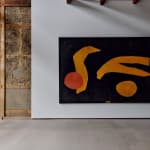Yamaguchi Takeo (1902–1983)
Form
Oil on board, framed
With a label signed by the artist, a certificcate of registration by Takeo Yamaguchi Artwork Registration Association
179.5 x 272 cm
191.5 x 283.5 cm (overall)
With a label signed by the artist, a certificcate of registration by Takeo Yamaguchi Artwork Registration Association
179.5 x 272 cm
191.5 x 283.5 cm (overall)
Exhibitions
Takeo Yamaguchi. Tokyo: The Contemporary Art Gallery, Seibu Department Store in Ikebukuro, 1986.Literature
Takeo Yamaguchi Catalogue Raisonné. Tokyo: Kodansha, 1981.
At that time, my heart was drawn towards celestial maps, microscopic images, and large natural systems. From Showa 12 (1937), while searching for these in my subjects, I somehow created a form that synthesized these elements. In Showa 14 (1939), this form became a simple oval, then a pure-white circle, then in the following year it broke down into something resembling a white wall riddled with worms. (“Footprints of a Certain Time – An Artist’s Memoir,” Art Journal, no. 5).
The work described as “riddled with worms” was probably Line C, a 1946 work that Yamaguchi Takeo submitted to the Nika-kai Exhibition. Lines appear from all sides of a circle and wrinkle towards the center to represent the phenomena of life emanating from celestial bodies and microscopic organisms. Eventually, this circle “riddled with worms” assumed a new name within Yamaguchi’s mind and in 1947 he named the work Katachi (象, form).
In 1948 the pronunciation of the title evolved into Sho (象; form) and in 1949 it became simply Katachi (かたち; form) and then Katachi (形象; form). The name was tweaked again to become Katachi (象; form) in 1951 and Keisho (かたち; form) in 1952. From around 1954, works containing circles were titled Katachi (かたち; form) while those with no circles were named Kosei (構成; composition). From 1947 to around 1950, Yamaguchi began creating works that featured an equal distribution of circles and non-circular amorphous shapes.
From around 1951, though, Yamaguchi’s paintings began to comprise line-shaped sections and circular sections. His screens continued to be divided up equally between these two sections until around 1954.
This work is entitled Keisho (かたち; form) and it features a circular mass and an amorphous mass intertwining and moving dynamically from the left to the right. Yamaguchi began producing paintings comprised solely of linear strips from 1954, with his works then shifting from linear strips to flat surfaces, as epitomized by D (Planar Form). The title ‘Keisho (かたち)’ can be translated as ‘Form,’ an apt name for this monumental work.
Yamaguchi Takeo (painter; 1902–1983)
Born in Seoul, Yamaguchi studied painting at Hongo Institute of Western Painting, Kawabata School of Painting and Tokyo Fine Arts School in Japan. In 1927, he co-founded the Joto-kai group with Ushijima Noriyuki and Okada Kenzo, then traveled to Paris where he met Ossip Zadkine as a lasting influence. After returning to Japan, Yamaguchi not only actively participated in Nika-kai exhibition, but also co-founded Room Nine Art Association, Japan Avant-garde Art Club, and Japan Abstract Art Club (with Yoshihara Jiro and others). In the 1950s and 1960s, Yamaguchi became one of the leading abstract painters in Japan, exhibiting widely in Japan and internationally, including São Paulo Art Biennial, Guggenheim Museum New York, Expo ’70 in Osaka and many more.
The work described as “riddled with worms” was probably Line C, a 1946 work that Yamaguchi Takeo submitted to the Nika-kai Exhibition. Lines appear from all sides of a circle and wrinkle towards the center to represent the phenomena of life emanating from celestial bodies and microscopic organisms. Eventually, this circle “riddled with worms” assumed a new name within Yamaguchi’s mind and in 1947 he named the work Katachi (象, form).
In 1948 the pronunciation of the title evolved into Sho (象; form) and in 1949 it became simply Katachi (かたち; form) and then Katachi (形象; form). The name was tweaked again to become Katachi (象; form) in 1951 and Keisho (かたち; form) in 1952. From around 1954, works containing circles were titled Katachi (かたち; form) while those with no circles were named Kosei (構成; composition). From 1947 to around 1950, Yamaguchi began creating works that featured an equal distribution of circles and non-circular amorphous shapes.
From around 1951, though, Yamaguchi’s paintings began to comprise line-shaped sections and circular sections. His screens continued to be divided up equally between these two sections until around 1954.
This work is entitled Keisho (かたち; form) and it features a circular mass and an amorphous mass intertwining and moving dynamically from the left to the right. Yamaguchi began producing paintings comprised solely of linear strips from 1954, with his works then shifting from linear strips to flat surfaces, as epitomized by D (Planar Form). The title ‘Keisho (かたち)’ can be translated as ‘Form,’ an apt name for this monumental work.
Yamaguchi Takeo (painter; 1902–1983)
Born in Seoul, Yamaguchi studied painting at Hongo Institute of Western Painting, Kawabata School of Painting and Tokyo Fine Arts School in Japan. In 1927, he co-founded the Joto-kai group with Ushijima Noriyuki and Okada Kenzo, then traveled to Paris where he met Ossip Zadkine as a lasting influence. After returning to Japan, Yamaguchi not only actively participated in Nika-kai exhibition, but also co-founded Room Nine Art Association, Japan Avant-garde Art Club, and Japan Abstract Art Club (with Yoshihara Jiro and others). In the 1950s and 1960s, Yamaguchi became one of the leading abstract painters in Japan, exhibiting widely in Japan and internationally, including São Paulo Art Biennial, Guggenheim Museum New York, Expo ’70 in Osaka and many more.



